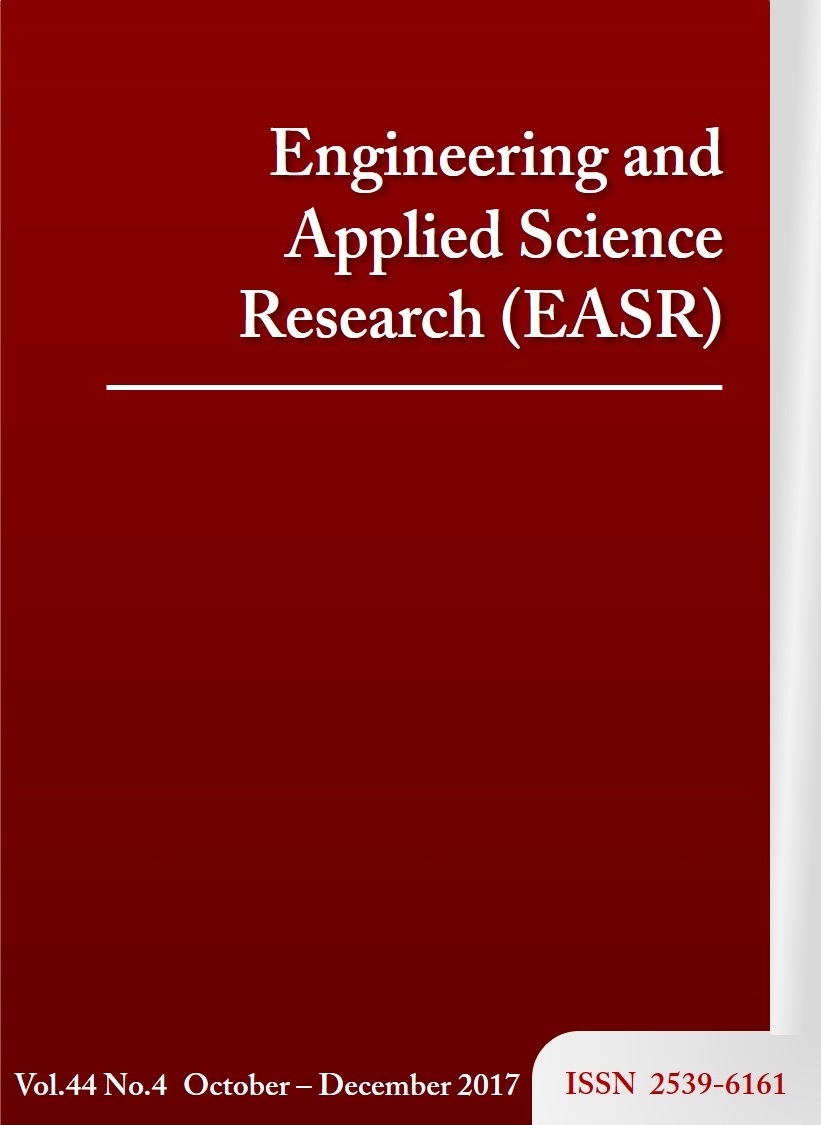Strain gauge based sensor for real-time truck freight monitoring
Main Article Content
Abstract
This study aims to develop a weight monitoring sensor for trucks used in sugarcane harvesting. Finite element simulation of the behavior of the load of harvested sugarcane in the bin acting on the truck chassis was established. The position of the weight sensors was determined based on the stress distribution results. The weight sensors were then designed and constructed. A testing unit representing the truck chassis was constructed for calibration of the weight sensors. The results showed that sensors should be installed on the chassis at 180 mm above the rear wheel mounting position, where the maximum stress was 7.64 MPa. The designed weight sensor consisted of four strain gauges attached to the end of two 30 mm diameter bolts. All strain gauges were wired into a Wheatstone bridge circuit (full bridge). A linear relationship between the signals from the sensor and weight was found for weights greater than 1000 N. The weight of sugarcane can be monitored during harvest to do yield mapping and support the combine while it harvests the field.
Article Details
This work is licensed under a Creative Commons Attribution-NonCommercial-NoDerivatives 4.0 International License.
References
Jisil P. Added value and stability to the sugar cane industry of the research. Bangkok: National research council of Thailand; 2014.
Eizo T, Ueno M, Saengprachatanarug K, Kawamitsu Y. Direct sugar content analysis for whole stalk sugarcane using a portable near infrared instrument. Journal of Near Infrared Spectroscopy 2013;4:281-287.
Tangwongkit R, Piya-Anant P, Tangwongkit B. Effect of harvesting sugar-cane by cane chopper in Thailand. Bangkok: Kasetsart University Research and Development Institute; 1995. [In Thai].
Rayanasuk K. The application of geographic information system for soil tillage prepartion planning of sugarcane planting in amphoe khon buri, changwat nakhon ratchasima. Ratchaphruek Journal 2011;8(3):153-159. [In Thai].
Chamnanhlaw C.Truck allocation in transporting sugar cane from field to industry [Thesis]. Khon Kaen, Thailand: Khon Kaen University; 2004. [In Thai].
Thienyaem T, Saengprachatanarug K, Ueno M, Eizo T. Analysis of discharge consistency and performance of a sugarcane billet planter with side-conveyer concept. KKU Engineering journal 2016;43(1):9-12.
Kusoncum C. Sugarcane Harvest and Transportation Management Models for Small Growers: A Case Study of Mitr Kalasin Sugar Mill [Thesis]. Khon Kaen, Thailand: Khon Kaen University; 2013. [In Thai].
Tangwongkit B. Testing and database design of sugarcane machinery. Final report on project to create knowledge and develop sugarcane under the master plan project in basic intelligence: Long-term project: Volume 1 Varieties and information. Bangkok: Kasetsart University; 2009. p. 329-330. [In Thai].
Ungsathittavorn K. The performance and development of sugarcane planting [Internet]. Bangkok: Office of The cane and sugar brand; 2014 [cited 2014]. Available from: http://oldweb.ocsb.go.th/udon/ Udon11/080802-Kittiphit02.htm
Yansyuen S. A study and development of a process for the removal of soil and sand from sugarcane in order to reduce soil and sand contamination in sugar processing [Dissertation]. Khon Kaen, Thailand: Khon Kaen University; 2008. [In Thai].
Waroonrod J. Tangchaichit K. The transition curve from plate-like to beam-like behavior in the free vibration of clamped-clamped beams-plates. KKU Engineering Journal 2007;34(1):105-117. [In Thai].
Fongsamootr T, Chartpuk P. Analyses of Stress Distribution in Overhanging Traffic Sign Pole Using Finite Element Method. KKU Engineering Journal 2006;33(6):587-597. [In Thai].
Seedakarn T, Tangchaichit K. The Effect of Fillet Shoulder Geometry to Fracture of Roller Mill Using Finite Element Method. KKU Engineering Journal 2007;34(6):733-747. [In Thai].
Pisaipan A. Strength Analysis of Cellular Material Structures by FEM [Thesis]. Khon Kaen, Thailand: Khon Kaen University; 2007. [In Thai].
Klaycham K, Athisakul C, Chucheepsakul S. Finite Element Method for Critical Top Tension Analysis of Neutrally Buoyant Riser. KMUTT Research and Development Journal 2014;37(4):429-446. [In Thai].
Somna R, Jaturapitakkul C. Use of Ground Bagasse Ash to Improve Compressive Strength, Water Permeability, and Chloride Resistance of Recycled Aggregate Concrete. KMUTT Research and Development Journal 2011;34(4)369-381. [In Thai].
Kuntiyawichai K, Puatatsananon W, Kaewkulchai G, Limkatanyu S. A comparative study on dynamic response of different floor types subjected to walking load. KKU Engineering Journal 2006;33(3):237-257. [In Thai].
Physics. Wheatstone bridge. [Internet]. 2000 [cited 2000]. Available from: http://www.rmutphysics.com.
Thinley K, Saengprachatanarug K, Ueno M, Eizo T. Development of Three-Dimensional Force Measurement Instrument for Plough in Mountain. Agricultural Mechanization in Asia, Africa, and Latin America 2016;14(4):66-73.


